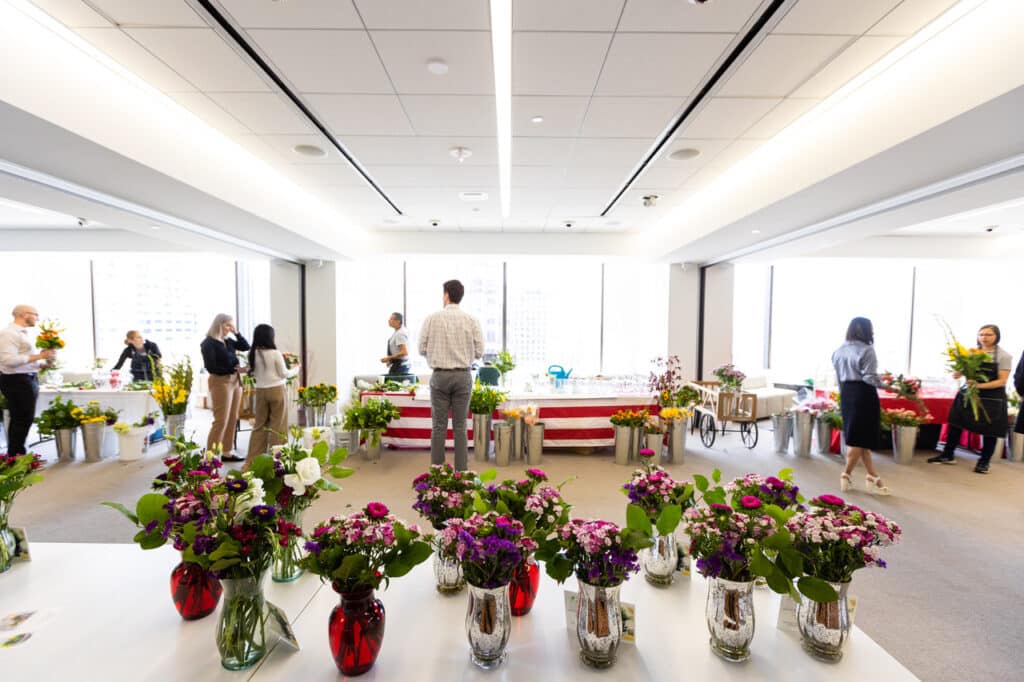Color speaks a universal language, and nowhere is that more apparent than in floral arrangements. Whether placed in a reception area, conference room, or workspace, the colors you choose can evoke specific emotions, shape perceptions, and subtly influence mood. For office managers and business owners, understanding the psychological impact of flower colors is more than just an aesthetic decision, it’s a strategic one.
This article breaks down how various hues affect workplace atmosphere and how smart floral design can support branding, morale, and even productivity.
How Colors Affect Emotions in the Workplace
Each color has psychological associations that can influence behavior and feelings. Floral arrangements provide an easy and beautiful way to bring these effects into a space without needing a full interior redesign.
Here are some commonly used flower colors and their emotional implications:
- Red: Passion, confidence, and energy. Use with intention, especially in high-stakes environments.
- Yellow: Optimism and clarity. Ideal for collaborative spaces and breakrooms.
- Blue: Calm, focus, and trust. Excellent for private offices or conference areas.
- White: Cleanliness and simplicity. Commonly used in clinical or minimalist spaces.
- Pink: Warmth and empathy. Great for welcome areas or service desks.
- Purple: Creativity and luxury. Often used in design firms or upscale venues.
Floral color planning isn’t just about beauty. It’s about emotional architecture. Offices benefit most when arrangements reflect the purpose of a room and the tone they wish to set. For those unsure where to begin, exploring examples of the right floral arrangements can provide inspiration tailored to different business settings.
Aligning Floral Colors with Your Brand Identity
If your business has a defined color palette, floral arrangements offer an elegant way to reinforce it visually. Aligning flowers with brand colors in lobbies or meeting rooms creates visual consistency and signals attention to detail.
To build brand-aware floral decor, consider the following:
- Choose blooms that naturally match or complement your logo colors
- Use neutral containers to avoid clashing
- Place arrangements where they’ll appear in client photos or video calls
- Rotate seasonal flowers while keeping within your palette
This approach helps the workplace feel more cohesive and intentional, whether you’re hosting guests or creating a positive environment for staff.
Seasonal Mood Shifts and Color Choices
Seasons influence how we respond to color. A cheerful spring palette may not carry the same emotional weight in winter, and a rich autumn scheme might feel heavy during the summer. Adapting your floral arrangements seasonally helps your space stay visually fresh and emotionally in tune.
- Spring: Soft pastels, greens, and florals like tulips or peonies
- Summer: Bright, bold colors like orange, coral, and vivid purple
- Fall: Warm earth tones, including rust, amber, and burgundy
- Winter: Cool whites, blues, and evergreen accents
This natural cycle encourages a subconscious connection to the world outside, even in an enclosed workspace. It’s also an opportunity to experiment with new combinations and textures, which can be refreshing for both employees and visitors. For inspiration on rotating displays, consider reviewing tips on seasonal floral arrangements.
Choosing the Right Palette for Specific Areas
Each area in an office has its own rhythm, function, and energy level. Matching floral colors to these nuances can enhance the environment’s purpose.
- Reception areas: Use welcoming and energizing colors like peach, pale yellow, or soft lavender
- Meeting rooms: Opt for blue or white arrangements to encourage focus and calm
- Breakrooms: Introduce brighter hues like orange or sunflower yellow for lighthearted relaxation
- Executive offices: Rich colors like burgundy or deep purple can add refinement
Matching the emotional tone of a room with your floral color palette avoids visual dissonance and helps occupants feel more comfortable and balanced.
Maintaining Consistency Without Being Predictable
While consistency in floral design reinforces your space’s identity, avoid being too predictable. Even within a defined color family, you can create variation through flower types, vase materials, and arrangement styles.
To keep things interesting:
- Rotate flower varieties monthly, even if the colors remain similar
- Use mixed textures like greenery, berries, or branches
- Shift between structured and organic arrangements
This subtle evolution keeps your displays dynamic and engaging without disrupting the overall atmosphere. A thoughtful rotation also gives you a chance to highlight seasonal favorites and respond to upcoming events or holidays without deviating from your brand.
Let the Experts Bring Your Colors to Life
Floral arrangements are more than pretty accents. When chosen thoughtfully, their colors can shape mood, communicate professionalism, and even improve workplace well-being. By considering psychology, seasonality, and strategic placement, office managers can make flowers an integral part of their visual communication toolkit.
Looking to create meaningful floral displays tailored to your office’s style and message? The Wright Gardner offers expert guidance and design services to make every arrangement feel intentional, impactful, and emotionally aligned.

